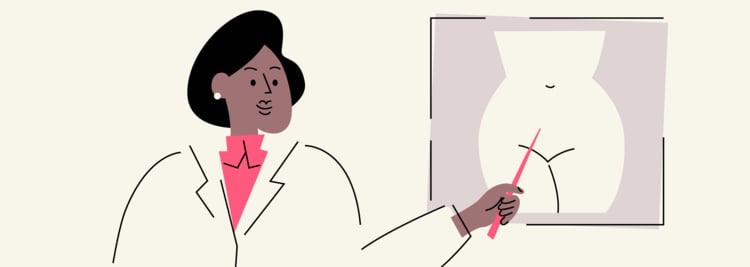As a woman, you possess the female version of a prostate, otherwise known as Skene (or paraurethral) glands. Here, Flo reveals the inner workings of the female prostate gland and the likelihood of developing female prostate cancer.
-
Tracking cycle
-
Getting pregnant
-
Pregnancy
-
Help Center
-
Flo for Partners
-
Anonymous Mode
-
Flo app reviews
-
Flo Premium New
-
Secret Chats New
-
Symptom Checker New
-
Your cycle
-
Health 360°
-
Getting pregnant
-
Pregnancy
-
Being a mom
-
LGBTQ+
-
Quizzes
-
Ovulation calculator
-
hCG calculator
-
Pregnancy test calculator
-
Menstrual cycle calculator
-
Period calculator
-
Implantation calculator
-
Pregnancy weeks to months calculator
-
Pregnancy due date calculator
-
IVF and FET due date calculator
-
Due date calculator by ultrasound
-
Medical Affairs
-
Science & Research
-
Pass It On Project New
-
Privacy Portal
-
Press Center
-
Flo Accuracy
-
Careers
-
Contact Us
Do Women Have Prostates? Female Prostate Cancer Explained


Every piece of content at Flo Health adheres to the highest editorial standards for language, style, and medical accuracy. To learn what we do to deliver the best health and lifestyle insights to you, check out our content review principles.
Do women have prostates?
Have you ever wondered, “do women have prostates”? In short, the answer is no. The primary function of the male prostate is to secrete prostate fluid, an important component of semen. However, there is a functional part of your own reproductive system that’s very similar.
Small glands, located on either side of your urethra and arising from the urogenital sinus, are called Skene glands. They create a link between your urethra and vagina that actually closes up during gestation. Now, let’s take a closer look at the female prostate gland and what it does.
What’s the purpose of the female prostate gland?
Similar to a man’s prostate, the Skene glands release a fluid that lubricates the opening of your urethra. Experts theorize that this fluid features antimicrobial properties and protects your urinary tract and bladder from bacterial infections. It’s uncertain whether the Skene glands drain into small ducts on either side of your urethra, or into the urethra itself.
The male prostate gland is believed to store infections, keeping them under containment until your body heals itself and can protect other areas from infection. As such, it is speculated that the Skene glands serve the same purpose in women.
Does female prostate cancer really exist?
Yes and no. Technically, you cannot develop prostate cancer without an actual prostate. However, the Skene glands have been known to foster cancerous growths, adversely affecting your reproductive system, urethra, and bladder.
Skene glands produce an ejaculate protein called prostate-specific antigen (PSA), which, when found at elevated levels in men, could point to the presence of cancerous cells. This explains why the PSA hormone also shows up in women diagnosed with breast cancer. Once they receive radiation therapy, their PSA levels drop. As a result, many doctors closely monitor PSA levels during cancer treatment.
That’s why the answer to “Can women get prostate cancer?” is somewhat contradictory. Cancer in the Skene glands can mimic prostate cancer in men. Fortunately, this disease is extremely rare and comprises only 0.003% of female genital cancers. It typically affects older, post-menopausal women and produces very small tumors. Treatment might include radiation therapy and removal of the glands.
Symptoms of female prostate cancer
Aside from a spike in PSA levels, there are other symptoms of prostate cancer in women to look out for. As expected, they mimic the signs of male prostate cancer, such as pressure on the bladder, a frequent need to urinate, and painful urination. Soreness in the lower pelvis, itching around the vaginal opening and urethra, painful sex, and disrupted menstrual cycles are all indicators of prostate cancer in women. Because of how rarely it occurs, patients who develop cancer in the female prostate gland are often misdiagnosed.
Technically, you cannot develop prostate cancer without an actual prostate. However, the Skene glands have been known to foster cancerous growths, adversely affecting your reproductive system, urethra, and bladder.
Problems with the Skene glands also go undetected when the symptoms of female prostate cancer fall in line with other reproductive diseases. This includes uterine or ovarian cancer and polycystic ovarian syndrome (PCOS), which are far more common. They all cause irregular periods, abdominal aches, sluggish metabolism along with weight gain, pressure behind the pubic bone, and painful sex.
Furthermore, the Skene glands have a tendency to grow cysts, which may be benign or cancerous. They’re manually detectable with your fingers and will probably feel like lumps around your vagina or urethra.
Typical symptoms of female prostate cancer aside, there are other more common indicators of cancer. These may include unexplained weight loss, hair loss, fatigue, generalized pain, blood in the urine, and painful urination.
Diagnosis and treatment of female prostate cancer
Due to the challenges of diagnosis, the signs of female prostate cancer are often mistakenly attributed to underlying conditions in the urinary tract or reproductive system.
Unfortunately, the initial stage of cancer in the Skene glands is asymptomatic. Once your menstrual cycle is disrupted, sex becomes painful, or you’re always feeling sick, the disease is quite advanced.
Treatment of female prostate cancer follows a similar strategy to that of other reproductive cancers. If chemical and radiation therapies aren’t successful in eradicating tumors, then surgery will likely be required to excise them. Frequently, the surgical removal of larger tumors and the chemical destruction of smaller tumors happen simultaneously.
In more severe cases, the organ or organs containing the cancerous growths must be removed as well. This could include your Skene glands, uterus, ovaries, or your entire reproductive system (i.e., a total hysterectomy). Whenever cancer in the Skene glands goes undiagnosed and untreated, bladder cancer may follow.
Medical experts have theorized that female prostate cancer could be linked to a history of sexually transmitted infections. The Skene glands, like the male prostate, act as guardians against infections that travel throughout the reproductive system.
Takeaway
“Do girls have prostates?” You’re not the only one to ever ask this question. Women have a female version of the prostate known as the Skene glands. They produce the same hormones as the male prostate, and both are believed to play a significant role in our reproductive systems.
Are you exhibiting any of the above signs of reproductive cancer? But have your scans and biopsies already ruled out the most common culprits? Then you may want to consult your doctor about checking your Skene glands.


Hey, I'm Anique
I started using Flo app to track my period and ovulation because we wanted to have a baby.


The Flo app helped me learn about my body and spot ovulation signs during our conception journey.


I vividly
remember the day
that we switched
Flo into
Pregnancy Mode — it was
such a special
moment.
Real stories, real results
Learn how the Flo app became an amazing cheerleader for us on our conception journey.

